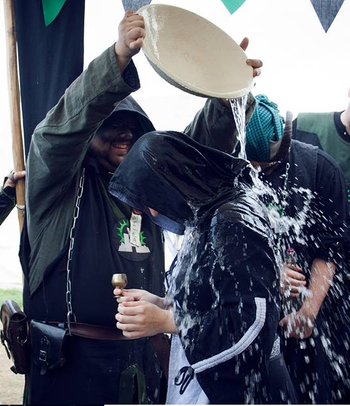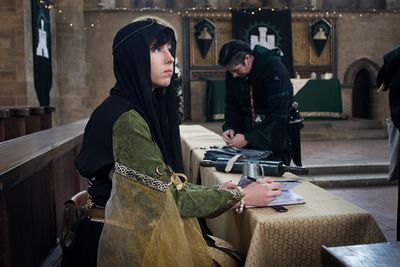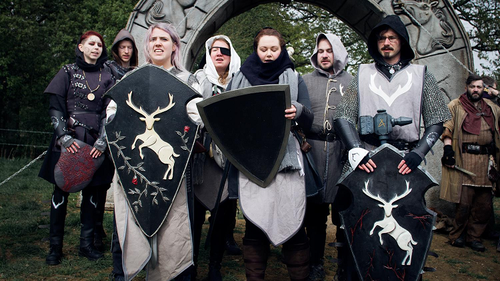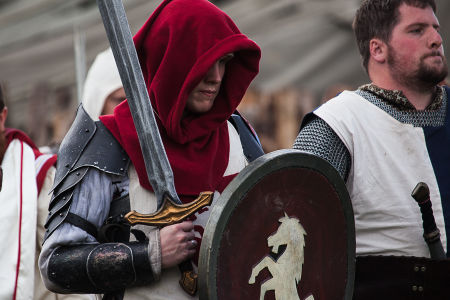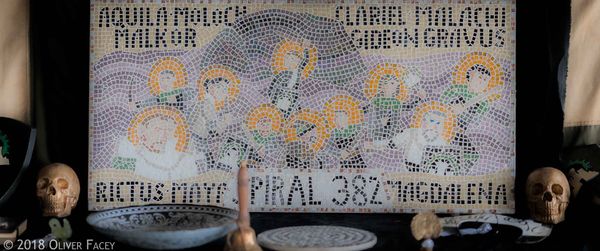Highguard culture and customs
Washing and cleanliness
Cleanliness is important to the Highborn. Highborn bathhouses are complex affairs with steam rooms, cold plunge pools, as well as heated baths and massage tables. A Highborn’s first impulse on arriving somewhere after a journey is to clean away the dust of the road. Small fountains, pools and fonts are commonly found outside Highborn chapterhouses, and even individual homes, so that those entering can perform a token cleansing of hands and face. Scented finger-bowls are common between courses at a meal.
“A pure soul in a pure body.”
In foreign lands or on campaign, cleanliness can be more difficult to maintain. If limited clean water is available, most Highborn will preserve the ritual aspects of washing, such as flicking a few drops over head and shoulders, dabbing a little on the eyes and forehead, or merely wetting the tips of fingers. If no clean water is available, symbolic gestures are performed instead; raising both hands to the face, then passing them over the head is a gesture that means “I would wash myself if I had water.” This gesture is occasionally used to mean “I wash my hands of this situation” and can even be used during an argument to express a sentiment roughly equivalent to “I am tired of you and want you gone”.
Recording history
Personal, as well as national, history is important to the Highborn. Many Highborn keep journals - diaries or collections of letters are the most common forms. These writings may be private, but it is also common for Highborn who are away from home to write short pieces intended to be shared with friends and family - reading travelogues and biographies are popular pastimes. The best writings are those that are considered to give a very personal viewpoint on events. Full of passion, they let the reader share the insights of the writer, and empathise with their emotions.
On death these personal writings are usually bequeathed either to a favoured family member or to the Stewards of the Dead, to form part of the library at the heart of the Necropolis. It is considered a great honour for an individual’s thoughts and experiences to be preserved as an inspiration and guide to future generations.
Competition and skill
Not all Highborn are warriors, but most enjoy competition, whether tests of fitness, skill or intellect. Especially popular at present is the Cathleon, a challenge based on a training regime favoured by many of the Unconquered, consisting of a footrace, javelin throws and a second footrace. The entire event is run in a single sequence, testing speed, skill and endurance. To win, the victor must run to the target, throw three javelins through a target hoop and then return to the start. There are no set distances or target-sizes; the competitors agree these details before a Cathleon begins.
Physical prowess is not the only way to earn respect from Highborn. Prestige lies in skill with tactical games such as chess, backgammon, othello, draughts, tafl and go. They also enjoy wagering on these games, although there is a general distaste for games of pure chance such as roulette or dice.
Art
Mosaics are popular, their swirling patterns recall the winds and the tides; at their hearts, stylised representations of the heroes of old. Vast and vaulted marble domes; dusty cloisters smelling of old parchment; cool villas with fountains at their heart fill the household with the song of the water. An artistic movement has been growing over the last two decades that moves away from the traditional complex mosaics towards a simpler style involving the shaping of coloured stone to fit together in designs reminiscent of stained glass – a more elegant and modern refinement of an ancient art.
Highborn musical traditions favour the flute and other wind instruments. On days when the wind is high, a chapterhouse resounds with the song of wind chimes, aeolian harps and bells.
The cowl
Before the dissolution of the Patrician Council, the tradition amongst the Highborn was that those carrying out funerary rites went hooded when doing so as a mark of respect. When the Navigator dissolved the Council, he did so hooded, a gesture believed to indicate the Council’s “death”. Since that time, a practice has arisen amongst many Highborn, particularly those in authority, to wear hoods or cowls, usually in the colours of their Chapter. The custom has it that when the hood is down, the wearer is speaking informally as themselves, but with the hood up they speak formally, such as representing others or passing a judgement. The act of raising or lowering the hood can, in such cases, change the atmosphere in a room significantly, and there are few sights as intimidating as a group of hooded Highborn moving with purpose.
Funerals
Death is an important moment in each spirit's cycle, with an opportunity to celebrate the virtues shown in the life that has now passed and meditate on whether the spirit might at last escape the Labyrinth. Mourners customarily wear sombre veils and cowls. Traditionally the dead have their hands and face carefully washed once they are in repose. They are then veiled for a final time and each person who has something to say upon the virtue of the individual takes their turn before the will of the deceased is read aloud. Bells are tolled throughout the proceedings to carry the words to the dead.
Testaments are common in Highguard. It is normal for bequests to be made on the basis of the virtues displayed by the recipient, rather than on any ties of blood. Any remaining chattels are gathered by the Chapter itself. All of this is done with some haste so that the body may be properly prepared for internment within their Chapter's mausoleum or, if they are particularly virtuous, within the Necropolis itself. Regardless of whether mortal remains are involved every Highborn wants their name inscribed on a monument in the Necropolis. Those of the briar lineage are almost never interred; their bodies are burnt and the ashes scattered over water.
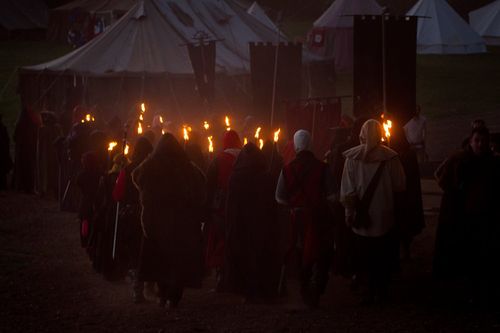
Day of the Dead
Taking place on the second day of the Winter equinox, the Day of the Dead is an important celebration that serves as a memorial for those lost in the preceding year. Respects are paid throughout the day with Chapters remembering those they have lost in their own traditional sombre and serious manner until dusk comes. As light fades from the sky it is common for the Highborn to begin a candle- and lantern-lit slow procession around their homes or chapterhouses. The celebrants walk in silence except for the intoning of bells or the speaking of the names of those who have passed into the Labyrinth; the procession often visits places that were important to a deceased individual in life.
Once the procession is complete, a celebration of those lives usually begins with songs and stories of the virtues of the Highborn. It is common for friends and loved-ones to share anecdotes and readings from their own journals or letters, or those of the departed.
The following morning is often used to celebrate those who have been born to, or joined, the nation in the last year, with many taking the opportunity to re-swear their oaths to Chapters and to Nation. It is also a common that Highborn give small meaningful gifts on this day, the most precious ones being considered by some to be those made by the gift-giver.
In pre-Imperial times, midnight on the Day of the Dead marked the end of one year and the beginning of the next. Old Highborn documents (and some traditionalist historians) still count the Day of the Dead as the last day of the year which can occasionally lead to confusion.
Icons and Artistry
Unsurprisingly, the Highborn favour art that expresses themes of Virtue and human destiny. In contrast to the starker shades favoured for clothing, Highborn art is often brightly coloured and tends toward the abstract. They decorate everything with mosaics, sculptures, and stained glass and also enjoy art that depicts these things. A valuable book might have a cover that is a piece of stained glass, be illuminated with tiny mosaic designs, or depict a beautiful sculpture on the frontispiece.
The horse has a special place in Highborn art. Although their great steeds are gone, the horse remains an enduring image of strength, loyalty, grace - and sorrow. The First Empress fought under a banner depicting a rearing silver or white stallion on black, and the horse became an early symbol of the Empire. The other heraldic beast associated with Highguard is the basilisk, a crested aquatic lizard. It can be found drowsing in marble, curled around alcoves or uncoiling across mosaic floors. Its eyes are always depicted shut as though asleep – except on warbanners where its crimson gaze sweeps the field for any sign of the enemies of the virtuous.
Bells are frequently depicted in Highborn iconography, and form a key part of decoration, architecture, and ceremony; they are a potent symbol of the virtue of Vigilance. A common design used to represent the nation of Highguard flag is the basilisk coiled around a bell; either the traditional black bell representing the Necropolis, or the white bell that symbolises the city of Bastion.
Further Reading
Core Brief
Additional Information
